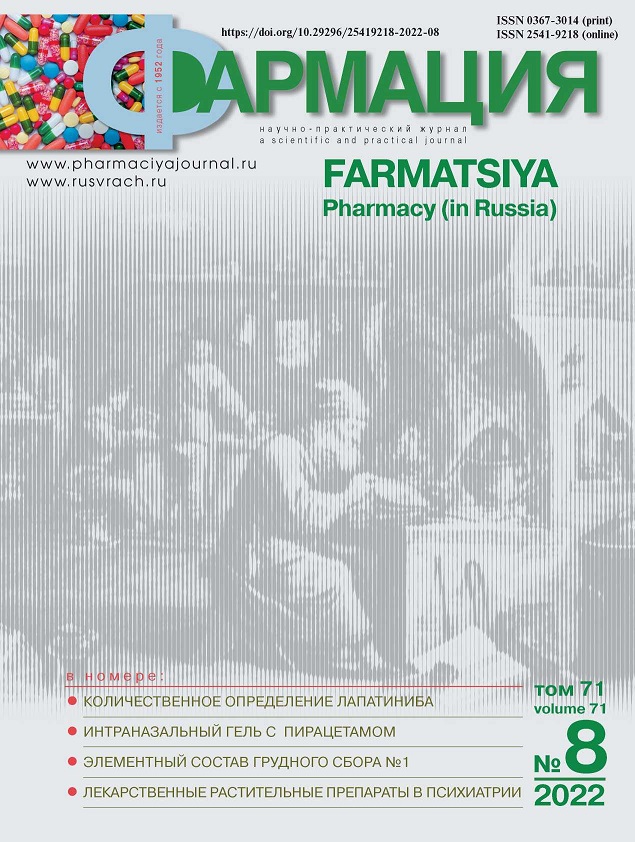Validation of the method for the quantitative determination of lapatinib in tablets during the "Dissolution" test
- Authors: Poskedova Y.A.1, Shprakh Z.S.1,2, Ignatieva E.V.2, Ramenskaya G.V.1
-
Affiliations:
- Sechenov First Moscow State Medical University (Sechenov University)
- FSBI " N.N. Blokhin National Medical Research Center of Oncology"
- Issue: Vol 71, No 8 (2022)
- Pages: 28-33
- Section: Pharmaceutical chemistry and pharmacognosy
- URL: https://journals.eco-vector.com/0367-3014/article/view/317443
- DOI: https://doi.org/10.29296/25419218-2022-08-04
- ID: 317443
Cite item
Abstract
Introduction. Lapatinib is used for targeted therapy of breast cancer caused by overexpression or activation of tyrosine kinase receptors of epidermal growth factor (Human epidermal growth factor receptors, HER/ErbB). For the determination of lapatinib in tablets, chromatographic methods are mainly used. However, spectrophotometry in the visible and ultraviolet regions of the spectrum can be considered as a more accessible and simple method of quantitative determination. To prove the suitability of the method for quantitative determination of lapatinib in tablets by UV spectrophotometry in the dissolution test, it is necessary to validate it.
The objective of the study was to validate the method for the quantitative determination of lapatinib during the dissolution test.
Material and methods. As an investigational drug, lapatinib tablets (film-coated tablets, 250 mg) obtained in the laboratory for the development of dosage forms of the FSBI " N.N. Blokhin National Medical Research Center of Oncology" was chosen. The "Dissolution" test was carried out in accordance with GPM.1.4.2.0014.15 "Dissolution for solid dosage forms", the quantitative determination of the released substance was carried out by UV spectrophotometry, the statistical processing of the results was carried out in accordance with GPM.1.1.0013.15 "Statistical processing of the results of a chemical experiment" and the recommendations of the Guidelines for pharmaceutical industry enterprises.
Results. When determining specificity, placebo interference was found to be less than 0,1%. A linear relationship between the concentration of lapatinib and the optical density of the solution has been proven. The values taken as true lay within the confidence intervals of the corresponding average results of analyzes obtained experimentally using validated method. When determining the repeatability, the value of the relative standard deviation (RSD, %) for the degree of dissolution of lapatinib did not exceed 2%. For the validated method, acceptable specificity, linearity, accuracy, and precision were proven in the concentration range from 0.025 mg/ml to 0.061 mg/ml, which corresponds to the range from 55% to 135%.
Conclusion. Validation of the method for lapatinib quantitative determination during the “Dissolution” test for the dosage form of film-coated tablets, 250 mg has shown the possibility of its use for quality control of the medicinal product.
Keywords
Full Text
About the authors
Yana Alekseevna Poskedova
Sechenov First Moscow State Medical University (Sechenov University)
Author for correspondence.
Email: yana.poskedova@outlook.com
ORCID iD: 0000-0001-7921-6354
Ph.D. student of the department of pharmaceutical and toxicological chemistry A.P. Arzamastsev institute of pharmacy A.P. Nelyubina, Sechenov First Moscow State Medical University (Sechenov University)
8/2, Trubetskaya str., Mosсow, 119991, Russian FederationZoya Sergeevna Shprakh
Sechenov First Moscow State Medical University (Sechenov University); FSBI " N.N. Blokhin National Medical Research Center of Oncology"
Email: z.shprakh@ronc.ru
ORCID iD: 0000-0003-3034-750X
Pharm D, Associate Professor of the department of Pharmaceutical Technology and Pharmacology; Sechenov First Moscow State Medical University (Sechenov University). Leading Researcher of the Laboratory of Chemical and Pharmaceutical Analysis, Federal State Budgetary Institution «N.N. Blokhin National Medical Research Center of Oncology» оf the Ministry of Health of the Russian Federation (N.N. Blokhin NMRCO)
8/2, Trubetskaya str., Mosсow, 119991, Russian Federation; 24, Kashirskoe highway, Moscow, 115522, Russian FederationElena Vladimirovna Ignatieva
FSBI " N.N. Blokhin National Medical Research Center of Oncology"
Email: chem_analysis@ronc.ru
ORCID iD: 0000-0002-9200-4492
PhD in pharmaceutical sciences, Leading Researcher of the Laboratory of Chemical and Pharmaceutical Analysis, Federal State Budgetary Institution «N.N. Blokhin National Medical Research Center of Oncology» оf the Ministry of Health of the Russian Federation (N.N. Blokhin NMRCO)
24, Kashirskoe highway, Moscow, 115522, Russian FederationGalina Vladislavovna Ramenskaya
Sechenov First Moscow State Medical University (Sechenov University)
Email: ramenskaya_g_v@staff.sechenov.ru
ORCID iD: 0000-0001-8779-3573
PharmD, Professor, Head of the department of pharmaceutical and toxicological chemistry A.P. Arzamastsev institute of pharmacy A.P. Nelyubina, Sechenov First Moscow State Medical University (Sechenov University)
8/2, Trubetskaya str., Mosсow, 119991, Russian FederationReferences
- Xuhong J. C., Qi X. W., Zhang Y. et al. Mechanism, safety and efficacy of three tyrosine kinase inhibitors lapatinib, neratinib and pyrotinib in HER2-positive breast cancer. Am. J. Cancer Res. 2019; 9 (10): 2103–19.
- Open database: The Human Metabolome Database (HMDB) [Internet]. Showing metabocard for Lapatinib (HMDB0015388). c2012. Available at: https://hmdb.ca/metabolites/HMDB0015388. [Accessed 12 Sep, 2022] (in Russian).
- Stuurman F.E., Nuijen B., Beijnen J.H. et al. Oral anticancer drugs: mechanisms of low bioavailability and strategies for improvement. Clin. Pharmacokinet. 2013; 52 (6): 399–414. doi: 10.1007/s40262-013-0040-2.
- Wan X., Zheng X., Pang X. et al. Incorporation of lapatinib into human serum albumin nanoparticles with enhanced anti-tumor effects in HER2-positive breast cancer. Colloids Surf B Biointerfaces. 2015; 136: 817–27. doi: 10.1016/j.colsurfb.2015.10.018.
- Budha N.R., Frymoyer A., Smelick G.S. et al. Drug absorption interactions between oral targeted anticancer agents and PPIs: is pH-dependent solubility the Achilles heel of targeted therapy? Clin Pharmacol Ther. 2012; 92 (2): 203–13. doi: 10.1038/clpt.2012.73.
- Shprakh Z.S., Poskedova, Y.A., Rramenskaya G.V. Modern instrumental methods for qualitative and quantitative analysis of lapatinib in biological fluids and dosage forms (review). International Journal of Applied Pharmaceutics. 2022; 14 (1): 7–12. doi: 10.22159/ijap.2022v14i1.42992
- Marieta L.C. Passos, M. Lúcia M.F.S. Saraiva. Detection in UV-visible spectrophotometry: Detectors, detection systems, and detection strategies. Measurement. 2019; 135: 896–904. doi: 10.1016/j.measurement.2018.12.045.
- Test "Dissolution" in the development and registration of medicines. Scientific and practical guide for the pharmaceutical industry. Ed. I.E. Shokhin. M.: Pero, 2015; 320 (in Russian).
- The State Pharmacopoeia of the Russian Federation. Ed. XIV. Tom 2. [Electronic resource]. Access mode: https://femb.ru/record/pharmacopea14 (in Russian). [Accessed 12 Sep, 2022] (in Russian).
Supplementary files









